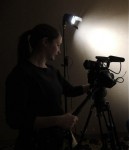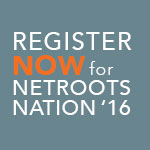After a great run, the Winning the Internet blog has been retired. However, you can still keep in touch with New Media Mentors here.

Amy Hendrick
As we get ready for Netroots Nation 2014, we’re taking a closer look at some of the convention’s most exciting training sessions. We’re interviewing the trainers and taking you inside some of online activism’s most popular and elusive topics.
Today we’re interviewing Amy Hendrick of AFSCME, who’ll be leading Using video to change hearts and minds with Jennifer Wynter-Phillis of SEIU.
NN14 Training Session
Using video to change hearts and minds
Well-produced video allows you to harness the power of visual storytelling and reach your audience in a deep and memorable way. It is now easier than ever to create video content, but even the most advanced cameras and software won’t produce compelling narratives all on their own. We’ll demonstrate the fundamentals of using visual storytelling in video production to empower you to tell more powerful, intimate stories that move your audience far more effectively than with just data and facts.
Interview
Q: Tell us about yourself and your experience with video and visual storytelling.
A: Combined, we have over 30 years experience using visual media to tell personal stories. We’ve worked pretty hard to set a new standard in the labor/progressive movement for video storytelling through our innovative work at both AFSCME and SEIU.
Through years of experience, we’ve learned how to create video content with high production value that stays true to the authenticity of subjects featured. We know how hard it is to put a camera in someone’s face and expect them to act normal. We are pros at making it a little less awkward.
Q: In your opinion, what is the most common mistake that organizations make when creating a video?
A: A good video is the marriage of both content and aesthetics. When creating a video it can be easy to let the power of a story take a backseat to talking points, flashy facts, and data – neither of which work well alone to change hearts and minds. Good storytelling should be at the heart – and good storytelling is personal.
Q: What are the two most important things to keep in mind when creating a video?
A: 1) Engage the audience. Great stories are all around us. The key is recognizing the distinction between a potential video opportunity versus content better suited for another medium. Ask yourself how you can make the story that you want to tell visually engaging. Do you have a subject who can communicate the issue through a personal story? The stakes are high with video — if you don’t capture an audience within the first 5 to 15 seconds, you’ve lost them completely.
2) Showing is always better than telling. Chances are that your subject will not be an actor, or even someone with media training. It’s important to know how to work with regular people to find the ‘meat’ of their story, and to make them feel comfortable enough to reveal themselves.
Q: Why should folks attend your session at Netroots Nation, and how can they connect with you?
A: Do you have an idea for a great video but aren’t sure how to get it there? We know how to make engaging video. We’ll show you easy ways to make your video look great, how to tell a story that is more than just talking heads, and how to weave it all together into a compelling package.
You can reach Amy on Twitter or Facebook.
To attend this training, or one of the 39 others at Netroots Nation 2014 in Detroit, register now.




Comments are closed.